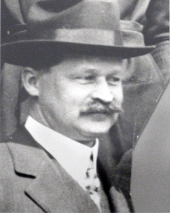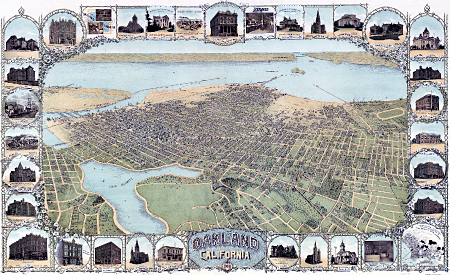The Swedish architect in San Francisco
From Falun, Sweden to Massachusetts and California.
-
 Frederick Soderberg, architect of Oakland’s Jenny Lind Hall. (Industrial Growth, 1915-1919: Oakland and Alameda County, p. 6. Oakland Public Library Main Branch, Oakland History Room)
Frederick Soderberg, architect of Oakland’s Jenny Lind Hall. (Industrial Growth, 1915-1919: Oakland and Alameda County, p. 6. Oakland Public Library Main Branch, Oakland History Room) -
-
The architect Frederick Soderberg was born in Falun, Sweden around 1866 and arrived in California from Massachusetts in 1896. Only a couple years later he was working as a draftsman in the architectural firm of D.F. Oliver in downtown Oakland. While there, in 1899, he drew a beautiful and detailed birdseye view of Oakland that shows the estuary and Alameda. Birdseye views were very difficult to produce, as you can imagine, as this was before the days of aerial photography and digital reproduction.
Soderberg’s birdseye view shows the ships and schooners docked in the estuary waters, as well as boats extending up into the estuary. This area was where schooners wintered for rest and repair, many of them staffed by Swedish sea captains and sailors. The map is rimmed with images of important civic buildings of the time, reflecting Soderberg’s interest in architecture.
The view also shows West Oakland, where Swedish immigrants were living by the 1880s and '90s, as well as the pier extending into the water in the outer harbor. The terminus for the transcontinental railroad had been completed there in 1869, attracting Swedish immigrants to work for the railroad and boatyards, as well as the ferry services to San Francisco. On the right side of Soderberg’s map is a large oval. This may be the racetrack at Shellmound Park, the large amusement park where Swedes of the time held Midsommar festivities. Oakland’s Vasa Tegner Lodge, among several other Swedish groups, held picnics and events there into the early years of the 20th century.
A copy of his birdseye view can be purchased from the Library of Congress; he is identified there as Fred Soderberg, as his name appears on the map. -
 Fred Soderberg’s 1899 Birdseye View of Oakland (City of Oakland Public Library, 2nd floor, on the wall outside the business office)
Fred Soderberg’s 1899 Birdseye View of Oakland (City of Oakland Public Library, 2nd floor, on the wall outside the business office) -
-
From draftsman to architect
By 1901 Soderberg had advanced from draftsman to architect. In this capacity he designed his four striking firehouses and several schools in Oakland. Today, two of his firehouses are still standing, one is still in use. The other has been painted red and restored by the fire department but is now used by a small start-up company.
Soderberg entered the political arena and was elected as a commissioner of Oakland in 1917. Known for his honesty and efficiency, he accepted not a dime of campaign contributions. He was elected City of Oakland’s Commissioner of Public Works in 1918, an extremely important and highly visible public office. This was a time of controversy and political shenanigans. Soderberg and Mayor Davie were not always on the same side of the issues and sometimes locked horns.
In the May 15, 1920 Oakland Tribune a squabble between Davie and Soderberg was reported. The mayor was demanding his own personal chauffeur, while Soderberg maintained that he could use the municipal chauffeur. The mayor claimed that Soderberg and one of his allies just wanted a spy in the mayor’s office, and that he would pay for his own personal chauffeur if he had to.
In 1919, there was a great deal of interest in developing Oakland’s 25-mile waterfront. Davie personally wrested control of the waterfront from the Central Pacific Railroad. Many, including Davie, pushed to dredge the inner harbor inside the estuary that extends between Oakland and Alameda to accommodate larger vessels.
Soderberg advocated strongly for dredging the western waterfront rather than the inner harbor. He argued that “The large ocean going vessels must discharge their cargoes on the western waterfront.” Clearly, Soderberg was considering the financial advantages and future development of the city. Interestingly, at a much later date, the Matson Navigation Company, founded by the Swedish-born William Matson, would take advantage of Oakland’s outer harbor and end up transforming it, with the introduction of containerized shipping.
The Swedish Ladies Society is an important example of organizations that started in San Francisco and branched out across the Bay. Formed in San Francisco in 1895, the first branch was formed in Oakland in 1916. The first president of the San Francisco society, Selma Soderberg Hanson, was born in Stockholm in 1856. Her middle name “Soderberg” is the same as the last name of the architect of Jenny Lind Hall; perhaps this is only a curious coincidence, but here is another possibility worth looking into ... -
By Kitty Hughes
-
-
-
